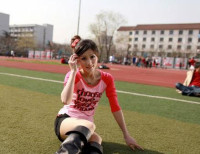Real-Time Compressive Tracking 论文笔记
来源:互联网 发布:藏文输入法软件下载 编辑:程序博客网 时间:2024/05/21 16:21
整体思想

.png)
.png)
.png)
.png)
.png)
.png)
.png)
.png)
.png)
1 利用符合压缩感知RIP条件的随机感知矩阵对多尺度图像进行降维
2 然后对降维的特征采用简单的朴素贝叶斯进行分类
算法主要流程

1 在t帧的时候,我们采样得到若干张目标(正样本)和背景(负样本)的图像片,然后对他们进行多尺度变换,再通过一个稀疏测量矩阵对多尺度图像特征进行降维,然后通过降维后的特征(包括目标和背景,属二分类问题)去训练朴素贝叶斯分类器()。
2 在t+1帧的时候,我们在上一帧跟踪到的目标位置的周围采样n个扫描窗口(避免去扫描整幅图像),通过同样的稀疏测量矩阵对其降维,提取特征,然后用第t帧训练好的朴素贝叶斯分类器进行分类,分类分数最大的窗口就认为是目标窗口。这样就实现了从t帧到t+1帧的目标跟踪。
Relate Work
Issuse of online tracking algorithms(update models with samples from observations in resent frames)
1 adaptive appearance models are data-dependent, but there does not exist sufficient amount of data for online algorithms at out set
2 drift problems
How To Do
1 生成随机测量矩阵
.png)
Achlioptas [16] proved that this type of matrix withs = 2 or 3 satisfies the Johnson-Lindenstrauss lemma. [17]证明,满足JL条件的话即满足CS的restricted isometry property in compressive sensing. 从而我们能够从降维后的v最好的重建x,其中v=Rx,R为随机矩阵
2 得到x向量
.png)
w,h是所选目标的宽长,我们用上面一系列不同尺度的矩形来对图像进行类似haar-like的向量生成,一共是wxh个rectangle filters,对每个像素进行卷积,生成m=(wh)^2个x,虽然m很大很大,因为随机测量矩阵十分稀疏,可以降到很小的n维
3 如下做降维处理
.png)
4 构建并更新分类器
假设降维后的数据是独立的分布,用以下朴素贝叶斯进行分类(4)
.png)
Since Diaconis and Freedman [23] showed that the random projections of high dimensional random vectors are almost always Gaussian, we assumed p(vi|y=1)andp(vi|y= 0) in the classifier to be Gaussian.
.png)
参数采用下式(6)进行递增的更新
.png)
类似高斯的直观图
.png)
5 整体算法为
.png)
Discussion
1 因为本文算法是data-independent的,所以不像1-tracker [10] ,compressive sensing tracker [9] 这些生成模型,不需要存储以前的训练样本;所采用广义的haar-like,不像[9][10]采用holistic templates for sparse representation,本文的特征更为鲁棒
2 PCA和它的变种广泛应用在了生成跟踪模型的方法里[1,6],但这些方法因为用的是holistic representation,对遮挡不鲁棒; 而且不一定能update correctly with new observations;压缩跟踪不存在self-taught learning approaches存在的这些问题,因为利用随机测量矩阵的这个模型是data-independent的;random projection 好于 principal component analysis
3 The tracking-by-detection methods often encounter the inherent ambiguity problems as shown in Figure below. Babenko et al. [8] introduced multiple instance learning schemes to alleviate the
tracking ambiguity problem
.png)
4 measurement matrix is data-independent and no noise is introduced by mis-aligned samples
5 Similar representations, e.g., local binary patterns [26] and generalized Haar-like features [8], have been shown to be more effective in handling occlusion.
Experiment
1 用到的评价标准 1 ROI 2 center location error
2 Algorithm combines the merits of generative(features?) and discriminative(bayes?) appearance models to account for scene changes
0 0
- Real-Time Compressive Tracking 论文笔记
- 《Real-Time Compressive Tracking》论文理解
- Real-Time Compressive Tracking
- Real-time Compressive Tracking
- Real-time Compressive Tracking
- Real-Time Compressive Tracking论文代码详细注释
- Real-Time Compressive Tracking(CT) 札记
- Real-Time Compressive Tracking(CT) 札记
- Real-Time Compressive Tracking阅读与分析
- real-time compressive tracking 所感
- Tracking算法学习之Compressive Tracking——Real-Time Compressive Tracking
- zhanglei 的Real-time Compressive Tracking的CT_C++_sq_v1代码
- Real-time Compressive Tracking目标跟踪算法理解
- 论文笔记:目标追踪-CVPR2014-Adaptive Color Attributes for Real-time Visual Tracking
- 13.5 论文笔记:目标追踪-CVPR2014-Adaptive Color Attributes for Real-time Visual Tracking
- 目标跟踪学习系列七:Real-time compressIve tracking(压缩跟踪)学习
- 视频跟踪论文读后感系列一:Adaptive Color Attributes for Real-Time Visual Tracking(CVPR2014)
- 论文阅读《Real-time part-based visual tracking via adaptive correlation filters》(1)
- UVA11796 Dog Distance 计算几何
- yacc lex 词法解析与语法解析
- Struck: Structrued Output Tracking with Kernels 论文笔记
- ASP.NET的分布式缓存介绍,MyCache ,Memcached ,CacheManager
- Python SMTPLIB
- Real-Time Compressive Tracking 论文笔记
- windows多执行绪代码及分析
- 架构师:一群善于沟通的技术领袖
- LCD帧缓存设备驱动
- hdu 1333 Smith Numbers
- LCD驱动的实现
- bash shell脚本之查看当前日期以及登陆用户
- 架构师:要成为百科全书式的智者
- C++指针心得


